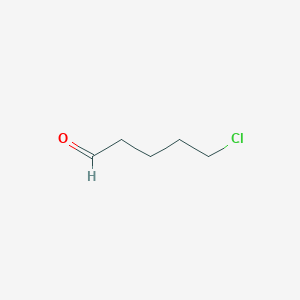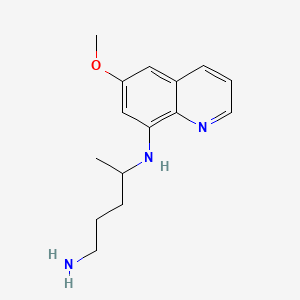
Primaquine
Vue d'ensemble
Description
La primaquine est un médicament principalement utilisé pour traiter et prévenir le paludisme, ciblant spécifiquement les formes hépatiques dormantes du parasite Plasmodium vivax et Plasmodium ovale . Elle est également utilisée en association avec d'autres médicaments pour traiter la pneumocystose . La this compound a été synthétisée pour la première fois en 1946 et figure sur la Liste des médicaments essentiels de l'Organisation mondiale de la santé .
Mécanisme D'action
Target of Action
Primaquine, an 8-aminoquinoline, primarily targets the liver stages of the malaria parasites, specifically Plasmodium vivax and Plasmodium ovale . It is also effective against the sexual stage of the Plasmodium parasite .
Mode of Action
It is believed to interfere with a part of the parasite (mitochondria) that is responsible for supplying it with energy . Without energy, the parasite dies, stopping the infection from continuing and allowing the person to recover .
Pharmacokinetics
This compound is well-absorbed in the gut and extensively distributed in the body without accumulating in red blood cells . Its elimination half-life is reported to be around 6 hours . This compound’s bioavailability is increased when taken with food or grapefruit juice .
Result of Action
The result of this compound’s action is the death of the malaria parasite. By interfering with the parasite’s energy supply, this compound stops the infection from continuing, allowing the person to recover . It also prevents the relapse of vivax and ovale malarias following treatment with a blood schizontocide .
Applications De Recherche Scientifique
Primaquine has a wide range of scientific research applications:
Analyse Biochimique
Biochemical Properties
Primaquine interacts with various enzymes, proteins, and other biomolecules. It is metabolized in humans via three pathways . The first pathway involves direct glucuronide/glucose/carbamate/acetate conjugation of this compound. The second pathway involves hydroxylation (likely cytochrome P450-mediated) at different positions on the quinoline ring, with mono-, di-, or even tri-hydroxylations possible, and subsequent glucuronide conjugation of the hydroxylated metabolites . The third pathway involves the monoamine oxidase catalyzed oxidative deamination of this compound resulting in the formation of this compound-aldehyde, this compound alcohol, and carboxy this compound (cPQ), which are further metabolized through additional phase I hydroxylations and/or phase II glucuronide conjugations .
Cellular Effects
This compound has significant effects on various types of cells and cellular processes. It interferes with a part of the parasite (mitochondria) that is responsible for supplying it with energy . Without energy, the parasite dies, stopping the infection from continuing and allowing the person to recover .
Molecular Mechanism
It may be acting by generating reactive oxygen species or by interfering with the electron transport in the parasite . This compound may also bind to and alter the properties of protozoal DNA .
Temporal Effects in Laboratory Settings
In laboratory settings, the effects of this compound change over time. A single low-dose of this compound was found to be haematologically safe in a population of G6PD-normal and G6PD-deficient African males without malaria . The study observed haemoglobin levels up to 28 days after drug administration .
Dosage Effects in Animal Models
In animal models, the effects of this compound vary with different dosages . The plasma AUC 0-last (µg h/mL) (1.6 vs. 0.6), T 1/2 (h) (1.9 vs. 0.45), and T max (h) (1 vs. 0.5) were greater for S-Primaquine as compared to R-Primaquine .
Metabolic Pathways
This compound is involved in various metabolic pathways. As mentioned earlier, it is metabolized in humans via three pathways . These pathways involve various enzymes and cofactors, and can also affect metabolic flux or metabolite levels .
Transport and Distribution
This compound is transported and distributed within cells and tissues . The concentration of S-Primaquine was found to be higher in all tissues . At T max, (0.5–1 h in all tissues), the level of S-Primaquine was 3 times that of R-Primaquine in the liver .
Méthodes De Préparation
Voies de synthèse et conditions réactionnelles
La primaquine est synthétisée par un processus en plusieurs étapes à partir de la 8-aminoquinoléine. . Les conditions réactionnelles impliquent généralement l'utilisation de bases fortes et de solvants organiques pour faciliter les réactions de substitution.
Méthodes de production industrielle
La production industrielle de this compound implique une synthèse à grande échelle utilisant des conditions réactionnelles similaires à celles de la synthèse en laboratoire, mais optimisées pour des rendements et une pureté plus élevés. Le processus comprend des étapes de purification rigoureuses pour garantir que le produit final répond aux normes pharmaceutiques .
Analyse Des Réactions Chimiques
Types de réactions
La primaquine subit diverses réactions chimiques, notamment:
Réduction: Le composé peut également subir des réactions de réduction, en particulier en présence d'agents réducteurs.
Substitution: La this compound peut participer à des réactions de substitution, en particulier au niveau des groupes amino et méthoxy.
Réactifs et conditions courants
Les réactifs courants utilisés dans les réactions de la this compound comprennent des agents oxydants comme le peroxyde d'hydrogène, des agents réducteurs comme le borohydrure de sodium et divers solvants organiques . Les réactions sont généralement réalisées sous des conditions contrôlées de température et de pH pour garantir la formation des produits souhaités.
Principaux produits formés
Les principaux produits formés à partir des réactions de la this compound comprennent ses formes oxydées et réduites, ainsi que divers dérivés substitués . Ces produits sont souvent étudiés pour leurs activités pharmacologiques potentielles.
Applications de recherche scientifique
La this compound a un large éventail d'applications de recherche scientifique:
Mécanisme d'action
Le mécanisme d'action exact de la this compound n'est pas entièrement compris. On pense qu'elle interfère avec la production d'énergie dans le parasite du paludisme en ciblant ses mitochondries . Cette perturbation conduit à la génération d'espèces réactives de l'oxygène, qui endommagent les composants cellulaires du parasite et finissent par le tuer . La this compound peut également se lier à l'ADN protozoaire et modifier ses propriétés .
Comparaison Avec Des Composés Similaires
La primaquine appartient à la classe des composés 8-aminoquinoléine. Les composés similaires comprennent:
Tafenoquine: Comme la this compound, la tafenoquine est utilisée pour traiter et prévenir le paludisme.
Chloroquine: Bien que ce ne soit pas une 8-aminoquinoléine, la chloroquine est un autre médicament antipaludique qui cible les stades sanguins du parasite.
La this compound se distingue par sa capacité à éliminer les formes hépatiques dormantes des parasites du paludisme, ce qui la rend essentielle pour prévenir les rechutes .
Propriétés
IUPAC Name |
4-N-(6-methoxyquinolin-8-yl)pentane-1,4-diamine | |
|---|---|---|
| Source | PubChem | |
| URL | https://pubchem.ncbi.nlm.nih.gov | |
| Description | Data deposited in or computed by PubChem | |
InChI |
InChI=1S/C15H21N3O/c1-11(5-3-7-16)18-14-10-13(19-2)9-12-6-4-8-17-15(12)14/h4,6,8-11,18H,3,5,7,16H2,1-2H3 | |
| Source | PubChem | |
| URL | https://pubchem.ncbi.nlm.nih.gov | |
| Description | Data deposited in or computed by PubChem | |
InChI Key |
INDBQLZJXZLFIT-UHFFFAOYSA-N | |
| Source | PubChem | |
| URL | https://pubchem.ncbi.nlm.nih.gov | |
| Description | Data deposited in or computed by PubChem | |
Canonical SMILES |
CC(CCCN)NC1=C2C(=CC(=C1)OC)C=CC=N2 | |
| Source | PubChem | |
| URL | https://pubchem.ncbi.nlm.nih.gov | |
| Description | Data deposited in or computed by PubChem | |
Molecular Formula |
C15H21N3O | |
| Source | PubChem | |
| URL | https://pubchem.ncbi.nlm.nih.gov | |
| Description | Data deposited in or computed by PubChem | |
Related CAS |
63-45-6 (1:2 PO4) | |
| Record name | Primaquine [INN:BAN] | |
| Source | ChemIDplus | |
| URL | https://pubchem.ncbi.nlm.nih.gov/substance/?source=chemidplus&sourceid=0000090346 | |
| Description | ChemIDplus is a free, web search system that provides access to the structure and nomenclature authority files used for the identification of chemical substances cited in National Library of Medicine (NLM) databases, including the TOXNET system. | |
DSSTOX Substance ID |
DTXSID8023509 | |
| Record name | Primaquine | |
| Source | EPA DSSTox | |
| URL | https://comptox.epa.gov/dashboard/DTXSID8023509 | |
| Description | DSSTox provides a high quality public chemistry resource for supporting improved predictive toxicology. | |
Molecular Weight |
259.35 g/mol | |
| Source | PubChem | |
| URL | https://pubchem.ncbi.nlm.nih.gov | |
| Description | Data deposited in or computed by PubChem | |
Physical Description |
Solid | |
| Record name | Primaquine | |
| Source | Human Metabolome Database (HMDB) | |
| URL | http://www.hmdb.ca/metabolites/HMDB0015219 | |
| Description | The Human Metabolome Database (HMDB) is a freely available electronic database containing detailed information about small molecule metabolites found in the human body. | |
| Explanation | HMDB is offered to the public as a freely available resource. Use and re-distribution of the data, in whole or in part, for commercial purposes requires explicit permission of the authors and explicit acknowledgment of the source material (HMDB) and the original publication (see the HMDB citing page). We ask that users who download significant portions of the database cite the HMDB paper in any resulting publications. | |
Boiling Point |
175-179 °C | |
| Record name | Primaquine | |
| Source | DrugBank | |
| URL | https://www.drugbank.ca/drugs/DB01087 | |
| Description | The DrugBank database is a unique bioinformatics and cheminformatics resource that combines detailed drug (i.e. chemical, pharmacological and pharmaceutical) data with comprehensive drug target (i.e. sequence, structure, and pathway) information. | |
| Explanation | Creative Common's Attribution-NonCommercial 4.0 International License (http://creativecommons.org/licenses/by-nc/4.0/legalcode) | |
| Record name | PRIMAQUINE | |
| Source | Hazardous Substances Data Bank (HSDB) | |
| URL | https://pubchem.ncbi.nlm.nih.gov/source/hsdb/6516 | |
| Description | The Hazardous Substances Data Bank (HSDB) is a toxicology database that focuses on the toxicology of potentially hazardous chemicals. It provides information on human exposure, industrial hygiene, emergency handling procedures, environmental fate, regulatory requirements, nanomaterials, and related areas. The information in HSDB has been assessed by a Scientific Review Panel. | |
Solubility |
5.64e-02 g/L | |
| Record name | Primaquine | |
| Source | Human Metabolome Database (HMDB) | |
| URL | http://www.hmdb.ca/metabolites/HMDB0015219 | |
| Description | The Human Metabolome Database (HMDB) is a freely available electronic database containing detailed information about small molecule metabolites found in the human body. | |
| Explanation | HMDB is offered to the public as a freely available resource. Use and re-distribution of the data, in whole or in part, for commercial purposes requires explicit permission of the authors and explicit acknowledgment of the source material (HMDB) and the original publication (see the HMDB citing page). We ask that users who download significant portions of the database cite the HMDB paper in any resulting publications. | |
Mechanism of Action |
Primaquine's mechanism of action is not well understood. It may be acting by generating reactive oxygen species or by interfering with the electron transport in the parasite. Also, although its mechanism of action is unclear, primaquine may bind to and alter the properties of protozoal DNA., The precise mechanism of action has not been determined, but may be based on primaquine's ability to bind to and alter the properties of DNA. Primaquine is highly active against the exoeryhrocytic stages of plasmodium vivax and plasmodium ovale and against the primary exoerythrocytic stages of plasmodium falciparum. It is also highly active against the sexual forms of (gametocytes) plasmodia, especially P. falciparum, disrupting transmission of the disease by eliminating the reservoir from which the mosquito carrier is infected., /Primaquine/ disrupts the parasitic mitochondria, thereby interrupting metabolic processes requiring energy., ... /Primaquine is one/ of /aromatic amine-containing/ xenobiotics ... capable to inducing oxidative injury in erythrocytes. These agents appear to potentiate the normal redox reactions and are capable of overwhelming the usual protective mechanisms. The interaction between these xenobiotics and hemoglobin leads to the formation of free radicals that denature critical proteins, including hemoglobin, thiol-dependent enzymes, and components of the erythrocyte membrane ... Oxidative denaturation of the globin chain decreases its affinity for the heme group, which may dissociate from the globin chain during oxidative injury ... The generation of free radicals may also lead to peroxidation of membrane lipids. This may affect the deformability of the erythrocyte and the permeability of the membrane to potassium. The alteration of the Na(+)/K(+) gradient is ... potentially lethal to the affected erythrocyte. Oxidative injury also impairs the metabolic machinery of the erythrocyte, resulting in a decrease in the concentration of ATP. Damage to the membrane can also permit leakage of denatured hemoglobin from the cell. Such free denatured hemoglobin can be toxic on its own. Free hemoglobin may irreversibly bind nitric oxide, resulting in vasoconstriction. Released hemoglobin may form nephrotoxic hemoglobin dimers, leading to kidney damage. /Oxidative hemolysis/ | |
| Record name | Primaquine | |
| Source | DrugBank | |
| URL | https://www.drugbank.ca/drugs/DB01087 | |
| Description | The DrugBank database is a unique bioinformatics and cheminformatics resource that combines detailed drug (i.e. chemical, pharmacological and pharmaceutical) data with comprehensive drug target (i.e. sequence, structure, and pathway) information. | |
| Explanation | Creative Common's Attribution-NonCommercial 4.0 International License (http://creativecommons.org/licenses/by-nc/4.0/legalcode) | |
| Record name | PRIMAQUINE | |
| Source | Hazardous Substances Data Bank (HSDB) | |
| URL | https://pubchem.ncbi.nlm.nih.gov/source/hsdb/6516 | |
| Description | The Hazardous Substances Data Bank (HSDB) is a toxicology database that focuses on the toxicology of potentially hazardous chemicals. It provides information on human exposure, industrial hygiene, emergency handling procedures, environmental fate, regulatory requirements, nanomaterials, and related areas. The information in HSDB has been assessed by a Scientific Review Panel. | |
Color/Form |
Viscous liquid | |
CAS No. |
90-34-6 | |
| Record name | Primaquine | |
| Source | CAS Common Chemistry | |
| URL | https://commonchemistry.cas.org/detail?cas_rn=90-34-6 | |
| Description | CAS Common Chemistry is an open community resource for accessing chemical information. Nearly 500,000 chemical substances from CAS REGISTRY cover areas of community interest, including common and frequently regulated chemicals, and those relevant to high school and undergraduate chemistry classes. This chemical information, curated by our expert scientists, is provided in alignment with our mission as a division of the American Chemical Society. | |
| Explanation | The data from CAS Common Chemistry is provided under a CC-BY-NC 4.0 license, unless otherwise stated. | |
| Record name | Primaquine [INN:BAN] | |
| Source | ChemIDplus | |
| URL | https://pubchem.ncbi.nlm.nih.gov/substance/?source=chemidplus&sourceid=0000090346 | |
| Description | ChemIDplus is a free, web search system that provides access to the structure and nomenclature authority files used for the identification of chemical substances cited in National Library of Medicine (NLM) databases, including the TOXNET system. | |
| Record name | Primaquine | |
| Source | DrugBank | |
| URL | https://www.drugbank.ca/drugs/DB01087 | |
| Description | The DrugBank database is a unique bioinformatics and cheminformatics resource that combines detailed drug (i.e. chemical, pharmacological and pharmaceutical) data with comprehensive drug target (i.e. sequence, structure, and pathway) information. | |
| Explanation | Creative Common's Attribution-NonCommercial 4.0 International License (http://creativecommons.org/licenses/by-nc/4.0/legalcode) | |
| Record name | PRIMAQUINE | |
| Source | DTP/NCI | |
| URL | https://dtp.cancer.gov/dtpstandard/servlet/dwindex?searchtype=NSC&outputformat=html&searchlist=27296 | |
| Description | The NCI Development Therapeutics Program (DTP) provides services and resources to the academic and private-sector research communities worldwide to facilitate the discovery and development of new cancer therapeutic agents. | |
| Explanation | Unless otherwise indicated, all text within NCI products is free of copyright and may be reused without our permission. Credit the National Cancer Institute as the source. | |
| Record name | Primaquine | |
| Source | EPA DSSTox | |
| URL | https://comptox.epa.gov/dashboard/DTXSID8023509 | |
| Description | DSSTox provides a high quality public chemistry resource for supporting improved predictive toxicology. | |
| Record name | Primaquine | |
| Source | European Chemicals Agency (ECHA) | |
| URL | https://echa.europa.eu/substance-information/-/substanceinfo/100.001.807 | |
| Description | The European Chemicals Agency (ECHA) is an agency of the European Union which is the driving force among regulatory authorities in implementing the EU's groundbreaking chemicals legislation for the benefit of human health and the environment as well as for innovation and competitiveness. | |
| Explanation | Use of the information, documents and data from the ECHA website is subject to the terms and conditions of this Legal Notice, and subject to other binding limitations provided for under applicable law, the information, documents and data made available on the ECHA website may be reproduced, distributed and/or used, totally or in part, for non-commercial purposes provided that ECHA is acknowledged as the source: "Source: European Chemicals Agency, http://echa.europa.eu/". Such acknowledgement must be included in each copy of the material. ECHA permits and encourages organisations and individuals to create links to the ECHA website under the following cumulative conditions: Links can only be made to webpages that provide a link to the Legal Notice page. | |
| Record name | PRIMAQUINE | |
| Source | FDA Global Substance Registration System (GSRS) | |
| URL | https://gsrs.ncats.nih.gov/ginas/app/beta/substances/MVR3634GX1 | |
| Description | The FDA Global Substance Registration System (GSRS) enables the efficient and accurate exchange of information on what substances are in regulated products. Instead of relying on names, which vary across regulatory domains, countries, and regions, the GSRS knowledge base makes it possible for substances to be defined by standardized, scientific descriptions. | |
| Explanation | Unless otherwise noted, the contents of the FDA website (www.fda.gov), both text and graphics, are not copyrighted. They are in the public domain and may be republished, reprinted and otherwise used freely by anyone without the need to obtain permission from FDA. Credit to the U.S. Food and Drug Administration as the source is appreciated but not required. | |
| Record name | PRIMAQUINE | |
| Source | Hazardous Substances Data Bank (HSDB) | |
| URL | https://pubchem.ncbi.nlm.nih.gov/source/hsdb/6516 | |
| Description | The Hazardous Substances Data Bank (HSDB) is a toxicology database that focuses on the toxicology of potentially hazardous chemicals. It provides information on human exposure, industrial hygiene, emergency handling procedures, environmental fate, regulatory requirements, nanomaterials, and related areas. The information in HSDB has been assessed by a Scientific Review Panel. | |
| Record name | Primaquine | |
| Source | Human Metabolome Database (HMDB) | |
| URL | http://www.hmdb.ca/metabolites/HMDB0015219 | |
| Description | The Human Metabolome Database (HMDB) is a freely available electronic database containing detailed information about small molecule metabolites found in the human body. | |
| Explanation | HMDB is offered to the public as a freely available resource. Use and re-distribution of the data, in whole or in part, for commercial purposes requires explicit permission of the authors and explicit acknowledgment of the source material (HMDB) and the original publication (see the HMDB citing page). We ask that users who download significant portions of the database cite the HMDB paper in any resulting publications. | |
Melting Point |
< 25 °C | |
| Record name | Primaquine | |
| Source | DrugBank | |
| URL | https://www.drugbank.ca/drugs/DB01087 | |
| Description | The DrugBank database is a unique bioinformatics and cheminformatics resource that combines detailed drug (i.e. chemical, pharmacological and pharmaceutical) data with comprehensive drug target (i.e. sequence, structure, and pathway) information. | |
| Explanation | Creative Common's Attribution-NonCommercial 4.0 International License (http://creativecommons.org/licenses/by-nc/4.0/legalcode) | |
| Record name | Primaquine | |
| Source | Human Metabolome Database (HMDB) | |
| URL | http://www.hmdb.ca/metabolites/HMDB0015219 | |
| Description | The Human Metabolome Database (HMDB) is a freely available electronic database containing detailed information about small molecule metabolites found in the human body. | |
| Explanation | HMDB is offered to the public as a freely available resource. Use and re-distribution of the data, in whole or in part, for commercial purposes requires explicit permission of the authors and explicit acknowledgment of the source material (HMDB) and the original publication (see the HMDB citing page). We ask that users who download significant portions of the database cite the HMDB paper in any resulting publications. | |
Synthesis routes and methods
Procedure details




Retrosynthesis Analysis
AI-Powered Synthesis Planning: Our tool employs the Template_relevance Pistachio, Template_relevance Bkms_metabolic, Template_relevance Pistachio_ringbreaker, Template_relevance Reaxys, Template_relevance Reaxys_biocatalysis model, leveraging a vast database of chemical reactions to predict feasible synthetic routes.
One-Step Synthesis Focus: Specifically designed for one-step synthesis, it provides concise and direct routes for your target compounds, streamlining the synthesis process.
Accurate Predictions: Utilizing the extensive PISTACHIO, BKMS_METABOLIC, PISTACHIO_RINGBREAKER, REAXYS, REAXYS_BIOCATALYSIS database, our tool offers high-accuracy predictions, reflecting the latest in chemical research and data.
Strategy Settings
| Precursor scoring | Relevance Heuristic |
|---|---|
| Min. plausibility | 0.01 |
| Model | Template_relevance |
| Template Set | Pistachio/Bkms_metabolic/Pistachio_ringbreaker/Reaxys/Reaxys_biocatalysis |
| Top-N result to add to graph | 6 |
Feasible Synthetic Routes
Q1: How does primaquine exert its antimalarial effects?
A1: While the exact mechanism of action remains incompletely understood, this compound is known to target the liver stages of Plasmodium vivax and Plasmodium ovale malaria, specifically the dormant hypnozoites responsible for relapses. This compound's activity is believed to stem from its metabolites, which are thought to generate reactive oxygen species, leading to oxidative damage within the parasite. [, , ]
Q2: What is the role of this compound metabolites in its antimalarial activity?
A2: this compound itself is a prodrug requiring bioactivation to exert its antimalarial effects. This bioactivation process involves enzymatic conversion, likely by cytochrome P450 enzymes, into active metabolites. [, ] One such metabolite, this compound-5,6-orthoquinone (5,6-POQ), has been identified as a key mediator of this compound's activity against Plasmodium parasites. []
Q3: Is this compound effective against the blood stages of malaria parasites?
A3: this compound exhibits limited activity against the asexual blood stages of Plasmodium falciparum compared to its potent activity against liver-stage hypnozoites. [, , ]
Q4: What is the molecular formula and weight of this compound?
A4: The molecular formula of this compound is C15H21N3O, and its molecular weight is 259.34 g/mol.
Q5: How is this compound metabolized in the body?
A5: this compound undergoes extensive metabolism in the liver, primarily via cytochrome P450 enzymes, particularly CYP2D6. This metabolism leads to the formation of various metabolites, some of which contribute to its antimalarial activity while others are associated with its toxicity. [, , ]
Q6: Does gender influence the pharmacokinetics of this compound?
A6: Pharmacokinetic studies indicated comparable this compound disposition between men and women, suggesting no need for dose adjustments based on sex. [, ]
Q7: How effective is this compound in preventing relapses of Plasmodium vivax malaria?
A7: this compound is highly effective in preventing P. vivax relapses when administered at appropriate doses and durations. Clinical trials have demonstrated a significant reduction in relapse rates with higher total this compound doses (≥5 mg/kg). []
Q8: Is there evidence of this compound resistance?
A8: While widespread this compound resistance has not been conclusively documented, several factors can impact treatment outcomes. These include variations in parasite susceptibility, host factors such as G6PD deficiency, and suboptimal adherence to prescribed this compound regimens. [, , ]
Q9: What is the role of CYP2D6 polymorphisms in this compound efficacy?
A9: CYP2D6 genetic variations, particularly those resulting in decreased enzyme activity, can significantly impact this compound metabolism and reduce its efficacy. This highlights the importance of understanding the pharmacogenetics of this compound for personalized treatment strategies. []
Q10: What are the major safety concerns associated with this compound use?
A10: The primary concern is hemolytic anemia in individuals with G6PD deficiency. This enzyme is crucial for protecting red blood cells from oxidative damage, and its deficiency can lead to drug-induced hemolysis, particularly with this compound and other 8-aminoquinolines. [, , , , ]
Q11: Are there strategies to improve this compound delivery to its target sites?
A11: Researchers have explored nanoparticle formulations of this compound to enhance its delivery to the liver, aiming to improve its efficacy against liver-stage parasites while potentially minimizing systemic exposure and associated toxicity. One study demonstrated that this compound-loaded chitosan nanoparticles achieved a threefold increase in liver this compound concentrations compared to conventional this compound in rats. [, ]
Q12: What analytical methods are employed to quantify this compound and its metabolites?
A12: Liquid chromatography coupled with mass spectrometry (LC-MS) is commonly utilized for the sensitive and specific quantification of this compound and its metabolites in biological samples. This technique allows for the separation and detection of different chemical entities based on their mass-to-charge ratio, enabling comprehensive pharmacokinetic analyses. [, ]
Q13: How is the enantiomeric separation of this compound and its metabolites achieved?
A13: Chiral chromatography, employing specialized stationary phases designed to separate enantiomers, is used to isolate and quantify individual enantiomers of this compound and its metabolites. This technique is crucial for understanding potential differences in the pharmacological and toxicological profiles of individual enantiomers. []
Avertissement et informations sur les produits de recherche in vitro
Veuillez noter que tous les articles et informations sur les produits présentés sur BenchChem sont destinés uniquement à des fins informatives. Les produits disponibles à l'achat sur BenchChem sont spécifiquement conçus pour des études in vitro, qui sont réalisées en dehors des organismes vivants. Les études in vitro, dérivées du terme latin "in verre", impliquent des expériences réalisées dans des environnements de laboratoire contrôlés à l'aide de cellules ou de tissus. Il est important de noter que ces produits ne sont pas classés comme médicaments et n'ont pas reçu l'approbation de la FDA pour la prévention, le traitement ou la guérison de toute condition médicale, affection ou maladie. Nous devons souligner que toute forme d'introduction corporelle de ces produits chez les humains ou les animaux est strictement interdite par la loi. Il est essentiel de respecter ces directives pour assurer la conformité aux normes légales et éthiques en matière de recherche et d'expérimentation.
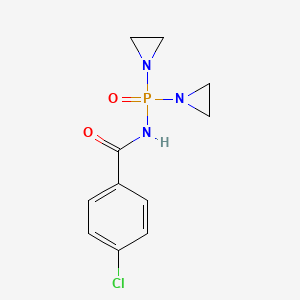

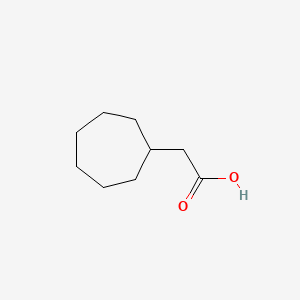


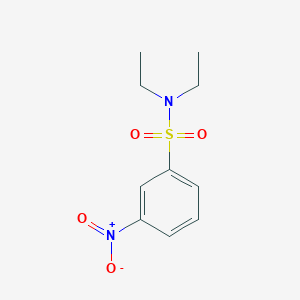
![2-Propanol, 1,1',1'',1'''-[[(2-hydroxypropyl)imino]bis(2,1-ethanediylnitrilo)]tetrakis-](/img/structure/B1584618.png)
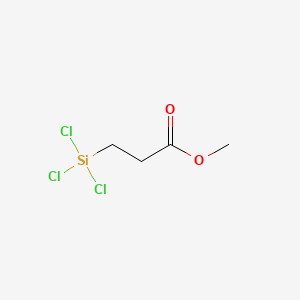
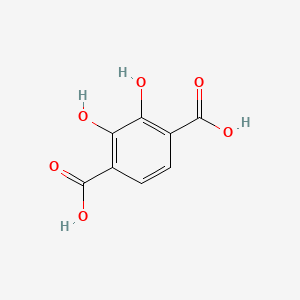
![1H-pyrrolo[2,3-b]pyridine, 4-nitro-, 7-oxide](/img/structure/B1584626.png)
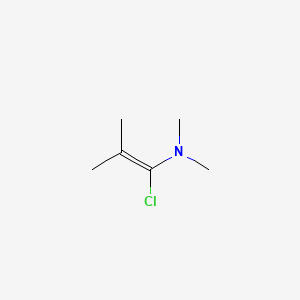
![3-Bromofuro[3,2-b]pyridine](/img/structure/B1584629.png)

